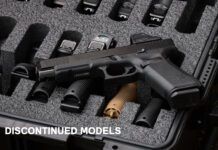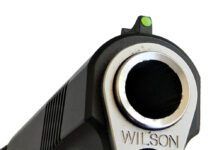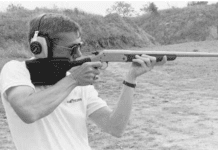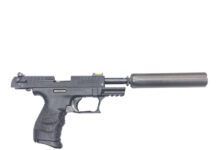Whenever a shooting match is scored with points divided by time, such as in Practical Shooting, reducing the time between shots (splits) becomes a major concern. Similarly, shooting fast and accurately in a defensive situation can be a lifesaving edge. Even when plinking, dealing with less recoil can yield “holier” tin cans and more fun.
Since recoil and the resulting muzzle flip is the force that pulls our sights away from the target, many products claiming to reduce recoil have entered the market. The makers of these products like to throw around numbers like 30 and 40 percent reduction in recoil, but most of these gadgets would be more suitable being sold from the back of a wagon in a grade B western movie. Still, we go on hoping. What shooter doesn’t want less recoil?
Two products that have come our way for evaluation are the full-length tungsten guide rod from Wilson Combat ($62.95) and the Sprinco Recoil reducing system ($59.95). Each is designed for use in the 1911 pistol, but Sprinco also sells this system for other semi-autos such as Glock and Sig Sauer as well as CZ. Which one works better. We tested them to find out.
Increase Mass, Reduce Recoil
We already recognize the value of the heavy guide rod, and so do many pistol manufacturers. The STI pistol in the accompanying pictures is intended for Limited Class competition and features not only a tungsten guide rod but a heavy bull barrel and frame featuring a full-length dust cover. Each of these design features are aimed at bringing more weight to the front end of the gun to fight recoil. Recoil energy is dampened by the addition of weight, or mass. We tried adding mass to our own Limited class pistol, a Springfield 1911 single-stack .45, by adding the heavy guide-rod from Wilson. We also tried a recoil-reduction system from Sprinco that functions in the place of a full-length guide rod and includes tungsten in the forward part of its construction.
How We Tested
Just adding either of these guide rods alone is not enough to reduce recoil like the full set of features on the STI did, but we nonetheless felt an improvement. The biggest problem we had was how to measure or at least quantify the reduction in recoil. We first sought to illustrate varying degrees of muzzle flip by seating the pistol in a Ransom Rest against a grid and using the bore line as the needle on a gauge, so to speak. Unfortunately, it was impossible to tell if the degree of resistance from the hinge action of the rest was consistent. We next considered a quorum of shooter’s impressions. We dispatched this idea on the basis of the “too many chefs” theory.
Instead, with input from numerous authorities, we decided on the following test procedure: Ten strings of six shots each at a single target 25 yards downrange by a single test shooter. Strings would be started with an electronic timer, start signal audible, with the timer registering elapsed time between each shot. The shooter would face downrange with the sights already on target. We used the same pistol and ammunition throughout with Oehler Chronograph results provided. The object was to deliver six hits of acceptable accuracy on a paper target with the shortest possible time between shots. Acceptable accuracy was defined as a group measuring one third of the total target area. In this case, that was an 8-inch square.
In preparation the test shooter used a number of precautions to minimize human inconsistencies. Pro-Grip was used to avoid slippage in grip. Ear plugs of 26db rating plus ear muffs rated at 29db were used to isolate the shooter from the pistol’s blast. As a result we sacrificed some initial reaction time in favor of trigger control. Since our senses work in consort, it has been documented that the lower noise level will reduce the incidence of jerking the trigger. Still, human error crept in.
The first, and slowest string of the day, was shot with the Sprinco device in place. This string buried the chances of the Sprinco having the best data and was probably a case of the test shooter in need of a warm up or just adapting to the timing of shooting the gun. Another human error might have crept in when we recorded a low split time of 0.32 seconds for the Wilson-equipped gun. We found only five holes on the target, but one could have been a double. Or not. We gave the Wilson the benefit of the doubt.
The accompanying table shows the elapsed times for every shot are close, but the comparison of best-to-worst string averages shows a slight edge for the Sprinco. Despite finding what could be termed a dead heat in many respects, we still feel there are differences between these two products that allowed us to pick a winner.
The overall feel produced by the two guide rods was markedly different, in our view. The solid tungsten guide rod from Wilson delivered a hard recoil that was over quickly. You had to be prepared to look through the muzzle flip and be ready when the front sight returned. Shooting our pistol with the Wilson tungsten guide rod in place required intensity and strength. A loss of concentration produced the slowest six-shot time of 0.81 seconds in String IV. The Sprinco device delivered a softer impulse, and the muzzle did not rise as much. Our shooter reported a higher level of control and less fatigue in the wrist and forearms. Indeed, while the final numbers are close, be sure to look at the consistency achieved after the initial runs. In both cases the test shooter settled into a consistent cadence. The average split times differ by only a small amount but the Sprinco was faster, even though our test shooter reported it actually seemed to feel slower. If this is truly the case then the shooter achieved a new level of awareness and shooting even faster splits may now be possible.
Gun Tests Recommends
We know that recoil-reduction systems are often the target of much skepticism. In our testing, both of these products allowed us to shave as much as two seconds off what we could do with the gun without the guide rods in place. With that fact in mind, we can recommend both the Wilson Combat Full-Length Tungsten Guide Rod, ($62.95) and the Sprinco Recoil Reducing System, ($59.95). But we prefer the latter product.
We suggest you try a test such as ours with your own pistol. Then order the Sprinco recoil reduction system with tungsten components and see if you can feel, and shoot, the difference.


























